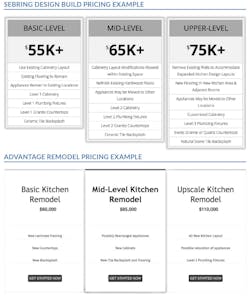Prequalify with a Pricing Guide
Clients come with all sort of questions, but one you can count on everyone asking is: How much? Our thinking is, why not answer it before we talk?
There’s a fear among remodelers that putting their pricing out there in the open will be bad for two reasons: 1. It won’t ever be 100% and accurate; and 2. It may scare away potential customers.
Let’s address these one at a time.
Range vs. Estimate
First thing to understand: These are not quotes. We don’t have calculators on our websites where clients can punch in what they want, where, and for what room to generate some sort of static figure.
Both pricing guides are an attempt to provide more financial transparency while streamlining and, ultimately, narrowing the sales funnel to true potential clients.
What Sebring Design-Build provides is a set of price ranges based on jobs over the past year, segmented by room type and job size. If a person wants to remodel their kitchen with Sebring, and they know they have a medium-sized kitchen and want to remove a wall, add custom cabinetry, and a natural stone tile backsplash, as well as new flooring, then we know they’re looking at an upper-level-tier job, which will run them $75,000 or more. We know that because we also provide details on what makes a job “upper-level” vs. “mid-level” vs. “basic-level.”
With Advantage Remodel, those numbers are a bit different—based on typical job size and area—but the system works the same way. What’s most important to remember is that these are not quotes. They’re estimated ranges that serve as symbols of our companies’ commitment to transparency as well as points of qualification.
Don’t Be Afraid to Scare People Away
There are some remodelers who simply want leads that their salespeople can sell to. If that works, then it works. We don’t want every lead: We want qualified leads, and that’s a big part of why we created our pricing guides.
If a person knows they want ‘1, 2, and 3’ done and can only spend ‘x’ on their remodel, but our average price for ‘1,2, and 3’ is much higher (between ‘y’ and ‘z’), then why would we waste time on a call telling them what we both already know: We’re not the right company for them. It’s okay to lose those leads, because they were never going to turn into clients.
We don’t want every lead. We want qualified leads, that’s a big part of why we created pricing guides.
It’s scary to lose out on a potential client, but in the long run, this system has made our selling more efficient, because the calls we get (assuming they’ve seen the website) are ones that are already familiar with what we offer and for what price. We know this because we have tracking on our site and can see what pages users have opened. In the event they’ve seen our pricing guide, clients are much more likely to come in qualified.
The truth is, clients are typically hesitant to bring up budget, but our pricing guides are a perfect bridge to that conversation early on—either clients have seen it and want to discuss it, or they haven’t and we can direct them to it and through it while we’re on the phone. By getting the financial details out of the way right off the bat, it leaves both us and the client with a good understanding of what can be done within their budget, ultimately making the design process much easier.
